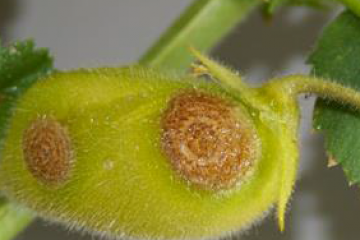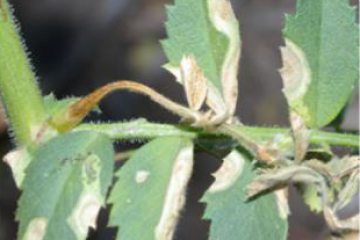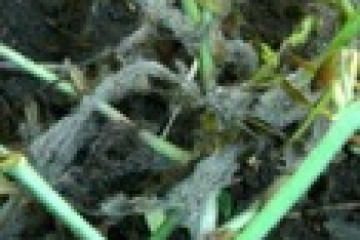Australian Pulse Bulletin
Chickpea fungicide guide: 2016 season
In many regions seasonal conditions are extremely wet, with continuing rain events and waterlogged soils. Decisions about the viability of crops need to be made early rather than later if disease has taken hold in the crop. It may be a better option to abandon crops and prepare for a following crop if diseases are apparent and environmental conditions continue to favour the disease over the next few weeks (saturated soils, average daily temperatures >15°C and high humidity).
Chickpea crops in greatest danger are the earlier crops sown on narrow row spacing (< 60 cm) where it will be difficult to control fungal diseases due to lack of air flow though the crops and good fungicide coverage.
The crop needs continuing fungicide protection for good pod fill and many paddocks are not accessible by ground sprayers to give adequate spray coverage required.
If an early decision about crop viability is made, extra costs for crop protection are avoided and nutrients will be available for following crops. In northern areas a summer crop may be an option, if herbicide residues are not a problem.
In light of the ongoing pressure for fungal disease in chickpea crops this year, Pulse Australia has compiled this Bulletin to provide a consolidated list of chemicals and approved usage patterns, for both on-label and well as approved by permit.
Note that some of the permit-enabled use patterns are via Emergency Use Permits, which have been specifically approved to deal with the current fungal conditions. These permits will expire once the 2016 season has concluded.
Sprays will control fungal disease, but when and how often to spray will depend on the varietal resistance, amount of infection, the impending weather conditions and the potential yield of the pulse crop.
Fungal disease control is geared around protection rather than curing. The first fungicide spray must be applied as early as necessary to minimise the spread of the disease. Additional sprays are required if the weather conditions favour the disease.
A fungicide spray at the commencement of flowering protects early pod set. Additional protection may be needed in longer growing seasons until the end of flowering. Fungicides remain effective for approximately 2–3 weeks. Keep in mind that all new growth after spraying is unprotected. In periods of rapid growth and intense rain (50 mm over several days) the protection period will reduce to around 10 days.
Timing of fungicide sprays is critical. As Ascochyta (AB) and Botrytis (BGM) can spread rapidly, DO NOT DELAY spraying. A spray in advance of a rainy period is most desirable. Despite some fungicide washing off, the disease will be controlled. Delaying until after a rainy period will decrease the effectiveness of the fungicide as the disease has started to spread.
The need for repeated fungicide sprays depends on the amount of unprotected growth, the amount of rainfall since spraying and the likelihood of a further extended rainy period. Unprotected crops can lose over 50% in yield. In severe cases the crop may drop all its leaves.
For more detailed information: Chickpea: Integrated disease management
-

Ascochyta blight on chickpea pod (G Cumming)
-

'Ghosting' caused by ascochyta blight on chickpea leaves (SARDI)
-

Botrytis grey mould (P Davis)
Fungicide Emergency Use Permits
- PER81533 Custodia / Ascochyta blight, grey mould / Current to 30-Sep-2017
- PER81406 Captan / Ascochyta blight, chocolate spot, grey mould / Current to 30-Sep-2018
- PER82964 Prosaro 420 / Ascochyta blight, grey mould / Current to 21-Oct-2016
- PER82976 Sumisclex 500 (Procymidone 500 g/L) / Botrytis grey mould / Current to 30-Nov-2016
- PER82973 Chlorothalonil / Ascochyta blight, grey mould / Current to 30-Nov-2016
- PER82995 Cabrio (Pyraclostrobin) / Ascochyta blight / Current to 30-Nov-2016
- PER830031 Filian (Boscalid) / Botrytis / Current to 30-Nov-2016
- PER83004 Rovral (Iprodione) / Botrytis / Current to 30-Nov-2016
- PER83068 Titan (Azoxyst 120 + Cypro 80) / Ascochyta / Current to 30-Nov-2016
- PER82994 Amistar (Azoxystrobolin) Ascochyta blight / Current to 30-Nov-2016
- PER83305 Propiconazole / Faba bean, Chickpea & Lentil / Ascochyta blight / Current to 30-Nov-2016
Fungicides registered for use on Chickpeas
| Chickpea Foliar Fungicide
|
Trade Name example
|
Ascochyta
|
Botrytis
|
WHP Harvest
|
|---|---|---|---|---|
| Chlorothalonil 720
|
CC Barrack 720
|
1.0–2.0 l/ha
|
Permit 1.0–2.0 l/ha
|
14 days
|
| Mancozeb 750
|
Dithane SC
|
1.0–2.2 l/ha
|
1.0–2.2l/ha
|
28 days
|
| Mancozeb 420
|
Penncozeb SC
|
1.8–3.95 l/ha
|
NR
|
28 days
|
| Carbendazim
|
Spin Flo
|
NR
|
500 ml/ha
|
28 days
|
| Captan 900
|
CC Captan 900
|
Permit 1.1 kg/ha
|
Permit 1.1 l/ha
|
14 days
|
| Captan 800
|
CC Captan 800
|
Permit 1.25 kg/ha
|
Permit 1.25 kg/ha
|
14 days
|
| Procymidone 500
|
Sumislex 500
|
NR
|
Permit 500 ml/ha
|
21 days
|
| Prothio 210 + Teb 210
|
Prosaro 420
|
Permit 600–700 ml/ha
|
NR
|
21 days
|
| Azoxystrobin 250
|
Amistar
|
Permit 0.5–1.1 l/ha
|
NR
|
14 days
|
| Azoxyst 120 + Teb 200
|
Custodia
|
Permit 1.0 l/ha
|
Permit 1.0 l/ha
|
28 days
|
| Pyroclostrobin 250
|
Cabrio
|
Permit 400–600 ml/ha
|
NR
|
30 days
|
| Boscalid
|
Filian
|
NR
|
Permit 1.2 kg/ha
|
21 days
|
| Azoxyst 120 + Cypro 80
|
Titan
|
Permit 400 ml/ha
|
NR
|
28 days
|
| Iprodione 500
|
Rovral Aquaflo
|
NR
|
Permit 1.0 l/ha
|
28 days
|
| Propiconazole
|
Tilt, Throttle, FMC Prop | Tilt 500 ml/ha Throttle 250 ml/ha FMC Prop 227 ml/ha
Permit |
NR | 14 days |
Many of the Emergency Use Permits have short term expiry dates (e.g. 30/11/2016)
NR = Not Registered (not effective for this disease)
Read the LabelAs with any chemical application, care should be taken to observe all the label recommendations for each product. Many of our pulse crops are exported for human consumption, so market access is dependent on having the product free of chemical residues. Australian has a reputation for providing clean and safe produce so it is vital that this is maintained by using chemicals according to regulations. All permits have label recommendations for use rate and with-holding periods (WHP) that must be observed so grain will comply with Maximum Residue Limits (MRL) allowable for market access. |
Key contacts
Pulse Australia Industry Development Managers
- Paul McIntosh
Phone: 0429 566 198 - Phil Bowden
Phone: 0427 201 946
Support and funding acknowledgement
Disclaimer
Information provided in this guide was correct at the time of the date shown below. No responsibility is accepted by Pulse Australia for any commercial outcomes from the use of information contained in this guide.
The information herein has been obtained from sources considered reliable but its accuracy and completeness cannot be guaranteed. No liability or responsibility is accepted for any errors or for any negligence, omissions in the contents, default or lack of care for any loss or damage whatsoever that may arise from actions based on any material contained in this publication.
Readers who act on this information do so at their own risk.
Copyright © 2015 Pulse Australia
All rights reserved. The information provided in the publication may not be reproduced in part or in full, in any form whatsoever, without the prior written consent of Pulse Australia. www.pulseaus.com.au
Last updated: 23 September 2016
